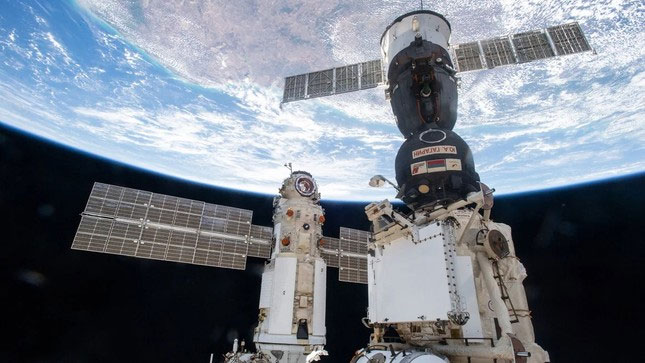International Space Station leak, NASA fears 'catastrophic failure'
A segment of the Russian-controlled International Space Station is leaking, causing pressure and air to escape. The US National Aeronautics and Space Administration (NASA) has expressed concern about the possibility of a "catastrophic incident" and has launched investigations and implemented contingency plans.
The first air leak on the International Space Station (ISS) was detected in 2019 in a tunnel connecting a Russian module, called Zvezda , to a docking port that welcomes spacecraft carrying cargo and supplies.
Although the leak was discovered a long time ago and some initial measures were taken to prevent the incident as much as possible, the air leakage rate of this module has reached its highest level this year.

The Zvezda module on the International Space Station is connected to another module. (Photo: NASA).
The problem was exacerbated by the fact that the suspected cracks were 'very small, not visible to the naked eye, and there were supports and pipes nearby, making it difficult to get diagnostic tools into these areas,' NASA said in a statement.
Despite efforts to stop air leaks, according to NASA, the leak rate still "ranges between 2 and 2.5 pounds of air per day."
US regulators now consider this the most pressing issue facing the aging space station, one that could threaten the safety of its crew, according to a recent report from NASA's Office of Inspector General.
The US space agency "has expressed concern about the structural integrity of the leaking module and the potential for a catastrophic failure ," Bob Cabana, a former NASA astronaut and chairman of NASA's ISS Advisory Committee, said during a meeting on the issue.
But while the Russian Federal Space Agency (Roscosmos) has directed astronauts to find and treat problem areas to help reduce the rate of leakage, the Russian team "does not believe that a catastrophic failure.is possible ," Cabana said.
'The Russians believe that the tunnel operations are safe – but they can't prove that to our satisfaction ,' Cabana added. 'And the United States believes that it's not safe, but we can't prove that to Russia's satisfaction.'
The disagreements continue despite several meetings between the two sides on the issue.

Roscosmos cosmonaut Oleg Novitskiy is seen in the Zvezda service module. (Photo: NASA).
NASA has taken precautions to ensure the safety of the crew, but in the long term NASA is concerned that the air leak could pose a threat to the safety of the crew and reduce the lifespan of the Space Station.
In its report, the Office of Inspector General noted: 'Although the ISS could operate if the hatch to the affected area was permanently closed, this could impact cargo deliveries as there would be one less delivery port. Permanent closure of the hatch would also require additional propellant to maintain the station's altitude and orientation.'
The US is now pushing for independent experts from both sides to assess the severity of the leak to help the two space agencies reach a consensus on the root cause and severity of the incident.
Meanwhile, astronauts and cosmonauts on the space station are required to take precautions, such as keeping the leak sealed at all times, except when it must be opened to unload cargo from the spacecraft to a nearby docking port.

Pallet chairs will be used in emergencies. (Photo: NASA).
In addition to requiring astronauts to close the entrance to the Russian sector when the Zvezda transition tunnel opens, the US agency is now installing an additional 'pallet seat' on the SpaceX Crew Dragon spacecraft.
The pallet seat sits on an area of the spacecraft normally used for cargo storage, and is essentially a piece of foam that astronauts can strap themselves into if they need to take the Crew Dragon spacecraft home in an emergency.
Specifically, the pallet seats are reserved for NASA astronauts to hitch a ride on Russia's Soyuz spacecraft to the space station, as they have done for years under a seat-swapping agreement between the US and Russia.
- What is NASA doing to fix the leak problem on the ISS?
- Ammonia leak detection on the international space station
- Successful treatment of leakage of ammonia gas on ISS station
- NASA opened the International Space Station for ... tourists and film makers from 2020
- NASA wants to sell ISS space station in the next 10 years
- The uncertain future of the ISS space station when NASA returns to the Moon
- NASA celebrates 40 years of the first space station project
- The ultrasound system helps determine the gas leak point on the ISS station
- ISS International Space Station is about to end its historic mission
- NASA promotes commercialization of ISS International Space Station
- Visit 'the longest road' on the ISS International Space Station
- Amazing Phenomenon in Space: Why is the International Space Station Rusting?
 Van Allen's belt and evidence that the Apollo 11 mission to the Moon was myth
Van Allen's belt and evidence that the Apollo 11 mission to the Moon was myth The levels of civilization in the universe (Kardashev scale)
The levels of civilization in the universe (Kardashev scale) Today Mars, the sun and the Earth are aligned
Today Mars, the sun and the Earth are aligned The Amazon owner announced a secret plan to build a space base for thousands of people
The Amazon owner announced a secret plan to build a space base for thousands of people